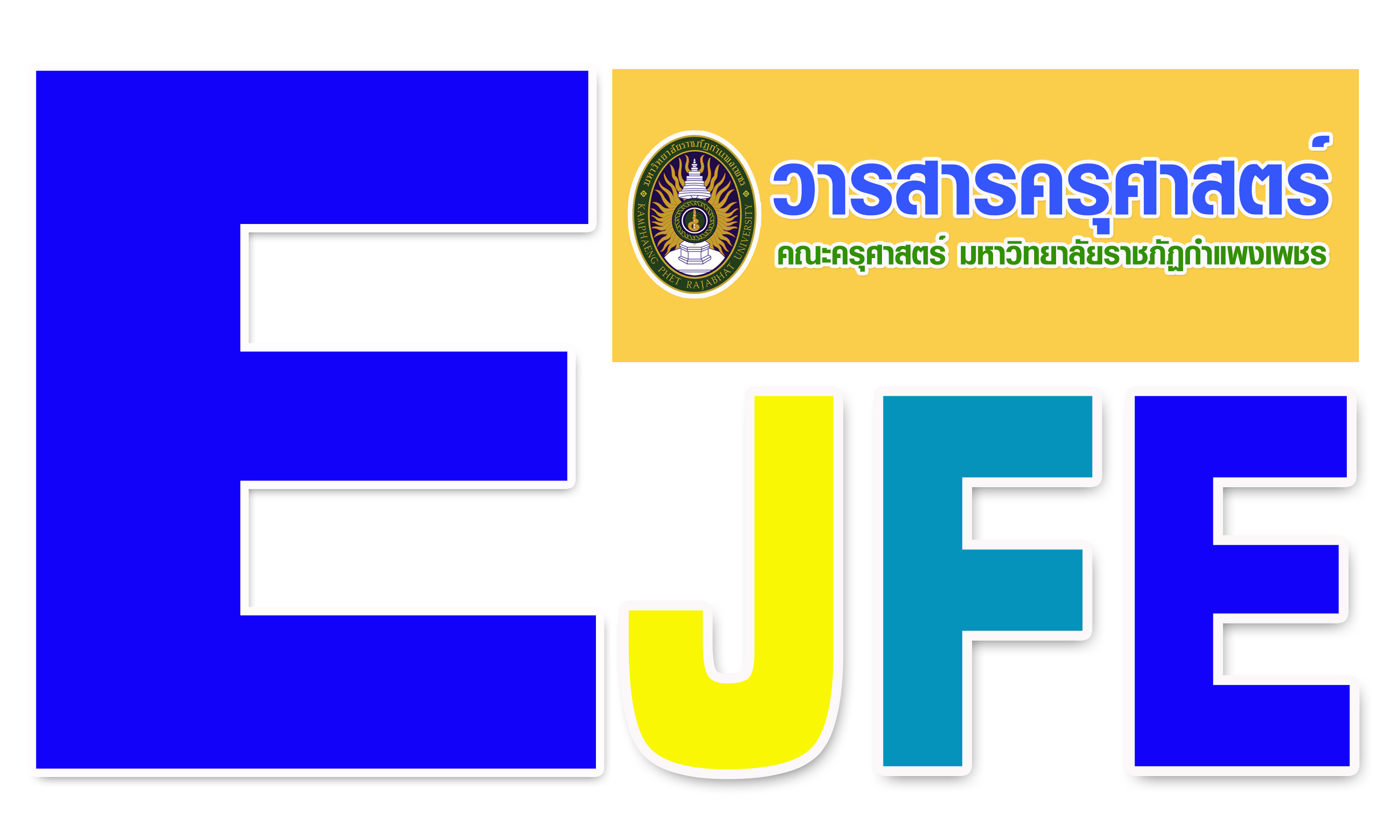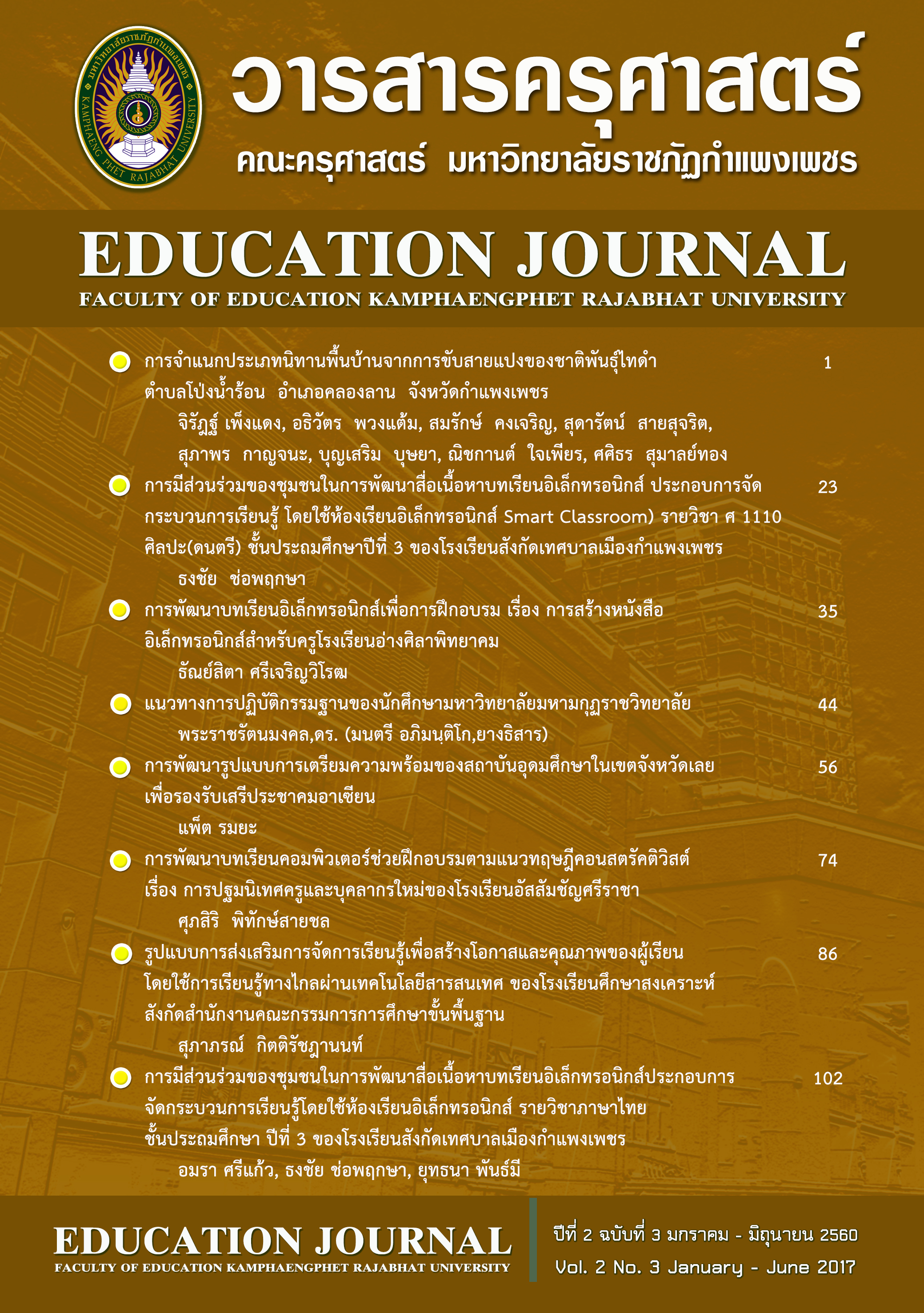STUDY RESULTS OF ELECTRONICS LESSON MEDIAS IN THAI LANGUAGE COURSES BY SMART CLASSROOMIN PRATOM SUKSA 3 OF SCHOOLS MUNICIPAL GOVERNMENT IN MAUNG KAMPHAENG PHET
Main Article Content
Abstract
The research on Study results of electronics lesson medias in Thai Language Pratomsuksa 3 , the development in lesson media which subserve on the enseignement of Maung Kamphaeng Phet municipal schools. There are main objectives in this research including, To make electronics lesson medias in English Pratomsuksa 3 successful in School enseignements. And For satisfaction of academic of Maung Kamphaeng Phet municipal schools learner who learn electronics lesson medias order to make this electronics lesson medias follow the objectives of this research, the researcher has chosen the method in a kind of developing and action research by using the example groups of students who are learning in Thai Language Pratomsuksa 3 in first semester year 2015 by specifically chose and set up research process steps including the steps in building and developing electronics lesson medias.
The result found that; 1. The comparison of the success in the study of Maung Kamphaeng Phet municipal schools when studied by electronics lesson medias after done the research and found out that in each unitenseignement and all. The example group of learner has the average score after learner with electronics lesson medias higher than before study of .01 this can proof that it is fit with the second set up hypothesis. 2. The research of learner satisfaction toward electronics lesson medias in Thai Language Pratomsuksa 3, the result of the research came out that student has high satisfaction with electronics lesson medias in every fields, according to the scores from highest to the lowest, teaching methods, lesson forms and websites, learning activities, the use of electronics lesson medias, and content presentations. These satisfaction can conclude the high
Article Details

This work is licensed under a Creative Commons Attribution-NonCommercial 4.0 International License.
CC Attribution-NonCommercial-NoDerivatives 4.0
References
คณะกรรมการการศึกษาแห่งชาติ, สำนักงาน.(2542). พระราชบัญญัติการศึกษาแห่งชาติ พ.ศ. 2542. สำนักนายกรัฐมนตรี.
จินตวีร์ เกษมศุข. (2554).การสื่อสารกับการเปลี่ยนแปลงของสังคม.กรุงเทพฯ: จุฬาลงกรณ์ มหาวิทยาลัย.
ทิพย์เกสร บุญอำไพ. (2540). การพัฒนาระบบการสอนเสริมทางไกลผ่านอินเทอร์เน็ต มหาวิทยาลัยสุโขทัยธรรมาธิราช. วิทยานิพนธ์ครุศาสตร์ดุษฎีบัณฑิต. บัณฑิตวิทยาลัย จุฬาลงกรณ์มหาวิทยาลัย.
ถนอมพร (ตันพิพัฒน์) เลาหจรัสแสง. (2545). หลักการออกแบบและการสร้างเพื่อการเรียนการสอน. กรุงเทพฯ : อรุณการพิมพ์.
นงเยาว์ เอี่ยมภาคีนิวัฒน์.(2550) .การพัฒนาบทเรียนคอมพิวเตอร์ช่วยสอนบนอินเตอร์เน็ตเรื่อง ฐานข้อมูลเบื้องต้น นครสวรรค์ : คณะวิทยาศาสตร์และเทคโนโลยี มหาวิทยาลัยราชภัฎนครสวรรค์.
พัชรา คะประสิทธิ์. (2546). การใช้อินเตอร์เน็ตเพื่อการเรียนรู้ของนิสิตมหาวิทยาลัยศรีนครินทรวิโรฒ. กรุงเทพฯ : มหาวิทยาลัยศรีนครินทรวิโรฒ.
ไพรัช ธัชยพงษ์ และ พิเชษฐ์ ดุรงคเวโรจน์.(2541). เทคโนโลยีสารสนเทศเพื่อการศึกษา. สำนักงานคณะกรรมการ การศึกษาแห่งชาติ.
มหาวิทยาลัยราชภัฎสวนดุสิต. (2550). วิชาเทคโนโลยีสารสนเทศเพื่อชีวิต. กรุงเทพฯ : สืบค้นเมื่อ 1 กุมภาพันธ์ 2557 จากhttp://srayaisom.dyndns.org/network/janphar/D4000107.html.
สุรางค์ โควตระกูล. (2548). จิตวิทยาการศึกษา. (พิมพ์ครั้งที่ 6) กรุงเทพฯ : โรงพิมพ์แห่งจุฬาลงกรณ์มหาวิทยาลัย.
สำนักงานคณะกรรมการการศึกษาแห่งชาติ. (2550). แผนพัฒนาการศึกษาแห่งชาติ. กรุงเทพฯ : ออนไลน์.
Ellis, R. (2003). Task-based language learning and teaching. Oxford University Press, Oxford, UK (call# UniM ERC 418.007ELLI), 27.


